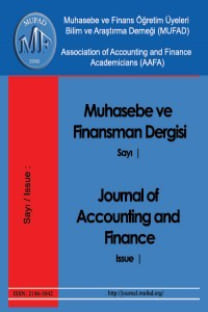The Roots of the global financial crisis (2007-?), effects of the crisis, partial exit from the crisis and current state
The Roots of the global financial crisis (2007-?), effects of the crisis, partial exit from the crisis and current state
___
- Abrahams, Clark Zhang, Mingyuan. (2009), Credit Risk Assessment, John Wiley And Sons, New York.
- Alantar, Doğan (2008), Küresel Finansal Kriz: Nedenleri Ve Sonuçları Üzerine Bir Değerlendirme, Maliye Finans Yazıları, Sayı 81.
- Amadeo, Kimberly (2009), GDP Current Statistics, http://useconomy.about.com/od/economicindicators/a/GDP-statistics.htm (2.3.2011).
- Arıkan, Ahmet Naci (2008), Amerika Birleşik Devletlerindeki Mali Kriz Ve Petrol Fiyatlarındaki Değişimler, Ümit Ofset, Ankara.
- Ashcraft, Adam Schuermann, Til (2008), Understanding The Securitization Of Subprime Mortgage Credit, Federal Reserve Bank Of New York Staff Reports, No. 318.
- BDDK (Bankacılık Düzenleme Ve Denetleme Kurumu) (2009a), Finansal Piyasalar Raporu-Aralık 2008, BDDK Strateji Geliştirme Başkanlığı, Ankara.
- BDDK (Bankacılık Düzenleme Ve Denetleme Kurumu) (2009b), Finansal Piyasalar Raporu-Eylül 2009, BDDK Strateji Geliştirme Başkanlığı, Ankara.
- BDDK (Bankacılık Düzenleme Ve Denetleme Kurumu) (2010a), Finansal Piyasalar Raporu-Aralık 2009, BDDK Strateji Geliştirme Başkanlığı, Ankara.
- BDDK (Bankacılık Düzenleme Ve Denetleme Kurumu) (2010b), Finansal Piyasalar Raporu-Mart 2010, BDDK Strateji Geliştirme Başkanlığı, Ankara.
- BDDK (Bankacılık Düzenleme Ve Denetleme Kurumu) (2010c), Finansal Piyasalar Raporu-Haziran 2010, BDDK Strateji Geliştirme Başkanlığı, Ankara
- BDDK (Bankacılık Düzenleme Ve Denetleme Kurumu) (2010d), Finansal Piyasalar Raporu-Eylül 2010, BDDK Strateji Geliştirme Başkanlığı, Ankara.
- Bianco, Katalina (2008), The Subprime Lending Crisis, CCH, Amsterdam. Boeri, Tito - Guiso, Luigi (2007),The First Global Financial Crisis Of The 21st Century, Felton, Andrew ve Reinhart, Carmen (edt.), The Subprime Crisis: Greenspans Legacy, CEPR, London, pp. 37-39.
- Büyükkarabacak, Berrak Valey, Neven T. (2009), The role of household and business credit in banking crises, Journal of Banking&Finance, No. 33, pp. 1-10.
- Crouhy, Michel Turnbull, Stuart (2008). The Subprime Credit Crisis, Of 07, http://www.maths-fi.com/Credit_Crisis_May_15_2008.pdf (12.3.2011).
- Dooley, Michael Hutchison, Michael (2009), Transmisson of the U.S. subprime crisis to emerging markets: Evidence on the decoupling-recoupling hypothesis, Journal of International Money and Finance, No. 28, pp. 1331-1349.
- Dougherty, Conor Evans, Kelly (2009). Economy In Worst Fall Since 82, http://online.wsj.com/article/SB123574078772194361.html#articleTabs%3Darticl e (12.3.2011).
- ECLAC (Economic Commissions For Latin America And The Caribbean) (2008), The United States Subprime Mortgage Crisis And Its Implications For The Caribbean, CDCC, Port Of Spain.
- Erdönmez, Pelin Ataman (2008), Küresel Kriz Ve Ülkeler Tarafından Alınan Önlemler Kronolojisi, Bankacılar Dergisi, Sayı 68, ss. 85-101.
- Faiola, Anthony (2009), U.S. Downturn Dragging World Into Recession, http://www.washingtonpost.com/wp- dyn/content/article/2009/03/08/AR2009030801216_pf.html (9.3.2011).
- Gup, Benton (2008), Handbook For Directors Of Financial Institutions, Edward Elgar Publishing, Williston. Hedlund, Erik Kahn, Hashim. (2009), The Subprime Crisis, Chalmers University Of Technology, Gothenburg.
- Hevner, Leland. (2009), The Perfect Portfolio, John Wiley And Sons, New York.
- IMF (International Monetary Fund) (2009), World Economic Outlook October 2009, IMF Publication Services, Washington.
- Jaffee, Dwight (2008), The U.S. Subprime Mortgage Crisis, The World Bank, Washington.
- Kowitt, Beth - Birger, John. - OKeefe, Brian (2008). Eight 2009 Economic Predictions, http://recession.org/library/2009-economic-predictions (11.3.2011).
- Richards, Dan (2008), The Subprime Crisis Explained, http://www.strategicimperatives.ca/blog/wp- content/themes/richards/files/TheSubprimeCrisisExplained.pdf (2.3.2011).
- Rosen, Richard (2007), The Role Of Securitization In Mortgage Lending, Chicago Fed Letter, No. 244.
- Sanders, Anthony (2008), The subprime crisis and its role in the financial crisis, Journal of Housing Economics, No. 17, pp. 254-261.
- Sapir, Jacques (2008), Global Finance In Crisis, Real-World Economics Review, No. 46, pp. 82-101.
- Shijian, Zhou (2009), When Will US Subprime Mortgage Crisis End?, http://www.antaike.com/gj/1212-english.PDF (17.3.2011).
- Smith, Veronica (2009), Global Recession Pushing Millions Into Poverty, http://www.france24.com/en/20090331-global-recession-pushing-millions-poverty (19.3.2011).
- Swan, Peter L. (2009), The political economy of subprime crisis: Why subprime was so attractive to its creators, European Journal of Political Economy, No. 25, pp. 124-132.
- T.C. Chicago Başkonsolosluğu Ticaret Ataşeliği (2008), Küresel Finansal Krizin Nedenleri Ve Olası Sonuçları Hakkında Bilgi Notu, http://www.musavirlikler.gov.tr/upload/CHI/Finansal%20kriz%20bilgi%20notu.p df (5.3.2011).
- TEPAV (Türkiye Ekonomi Politikaları Araştırma Vakfı) (2008). 2007-08 Küresel Finans Krizi Ve Türkiye: Etkiler Ve Öneriler, http://www.tepav.org.tr/tur/admin/dosyabul/upload/2007_08_Kuresel_Finans_Kriz i_ve_Turkiye.pdf (4.3.2011).
- TEPAV (Türkiye Ekonomi Politikaları Araştırma Vakfı) (2009), Küresel Krize Karşı TEPAV Politika Önerileri, http://www.tbb.org.tr/turkce/konferans/28042009.pdf (16.3.2011).
- Tucker, Michael (2008), The Development And Evolution Of The Subprime Mortgage Crisis, E-Journal Of Business and Economic Issues, Vol.3, No 2.
- Ulagay, Osman (2009), Krizin Dibi Bulunsa Bile Çıkış Kolay Olmayacak, http://www.milliyet.com.tr/Yazar.aspx?aType=YazarDetay&ArticleID=1092802& AuthorID=77&Date=10.05.2009 (21.3.2011).
- Zandi, Mark. (2008), Financial Shock, FT Press, New Jersey.
- (http://www.actionforex.com/action-insight/special-reports/2009-economic-forecast:-the- worst-is-yet-to-come-2009010473812/ , 29.3.2011) ( http://www.bls.gov/data , 20.3.2011)
- (http://www.economist.com/daily/chartgallery/displayStory.cfm?story_id=12811306&sou rce=features_box4 , 15.3.2011)
- ( http://www.inflationdata.com/inflation/Inflation_Rate/CurrentInflation.asp , 17.3.2011)
- ISSN: 2146-3042
- Yayın Aralığı: 4
- Başlangıç: 2005
- Yayıncı: Muhasebe ve Finansman Öğretim Üyeleri Derneği (MUFAD)
Türkiye'de 1988-2008 dönemindeki firma birleşmeleri,birleşme dalgaları ve genel tablo
Kobi'lerde ufrs ve basel II düzenlemelerinin farkındalığının araştırılması: Doğu marmara örneği
Hüseyin Ali KUTLU, N. Savaş DEMİRCİ
Cash flow statement that was reported according to Turkish accounting standards and its analysis
Attitudes of accounting professions and businesses about ethics: Turkey case
Kurumsal kaynak planlama sistemlerinin muhasebe süreçlerine etkisine yönelik İMKB'de bir araştırma
Bankalarda vadeye kadar elde tutulacak menkul kıymet işlemleri ve etkin faiz yöntemi
